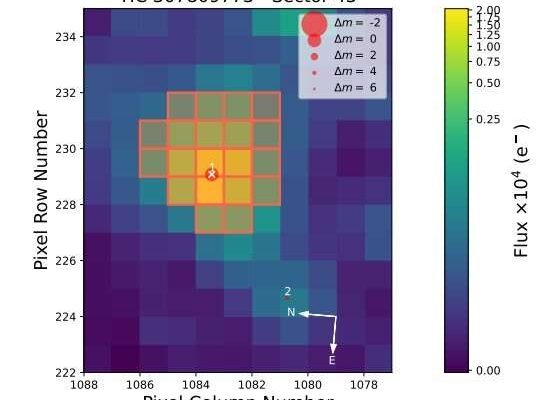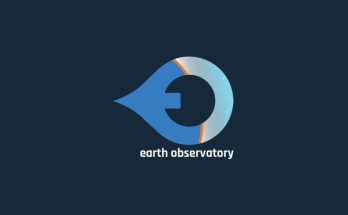Two rocky exoplanets discovered. Credit: TESS target pixel file image of HD 260655. Credit: Luque et al, 2022
Using NASA’s Transiting Exoplanet Survey Satellite (TESS), astronomers have detected two rocky alien worlds orbiting a nearby M dwarf star known as HD 260655. The newly found exoplanets are larger and at least two times more massive than the Earth. The finding is reported in a paper published April 21 on arXiv.org.
TESS is conducting a survey of about 200,000 of the brightest stars near the sun with the aim of searching for transiting exoplanets. So far, it has identified over 5,600 candidate exoplanets (TESS Objects of Interest, or TOI), of which 205 have been confirmed so far.
Now, a team of astronomers led by Rafael Luque of the University of Chicago confirmed another two planets monitored by TESS. They report that transit signals have been identified in the light curve of the bright M dwarf HD 260655 (or TOI-4599). The planetary nature of these signals was confirmed by archival and new precise radial velocity (RV) measurements.
“This work presents the discovery and characterization of a multiplanetary system orbiting the nearby M dwarf HD 260655. Transit observations from TESS detected two small planet candidates that were confirmed with independent RV data from the HIRES and CARMENES instruments taken since 1998 and 2016, respectively,” the researchers wrote in the paper.
The exoplanet closer to the parent star received designation HD 260655 b. It has a radius of about 1.24 Earth radii and is some 2.14 times more massive than our planet, which yields a density level of 6.2 g/cm3. HD 260655 b orbits its host every 2.77 days, at a distance of around 0.03 AU from it. Its equilibrium temperature was estimated to be 709 K.
The second newly found planet, HD 260655 c, is larger and more massive than its neighbor. The results show that it has a radius of 1.53 Earth radii, while its mass is approximately 3.09 Earth masses. Therefore, the density of this planet was calculated to be 4.7 g/cm3. HD 260655 c is separated from the parent star by 0.047 AU, has an orbital period of 5.7 days, and equilibrium temperature of about 557 K.
The star HD 260655, located some 32.6 light years away, is of spectral type M0 V and is about 56 percent smaller and less massive than the sun. The star has a metallicity level of -0.43 and is estimated to be between two and eight billion years old. HD 260655 is relatively bright (with apparent brightness of 6.7 mag) and its effective temperature is 3,803 K.
Based on the derived densities of the two new alien worlds, the astronomers concluded that they both have rocky composition. However, they noted that while HD 260655 b has a density in perfect agreement with the Earth’s, the density of HD 260655 c suggests an internal composition void of iron and fully made of silicates.
Summing up the results, the researchers noted that their discovery makes HD 260655 the fourth closest known multi-transiting planetary system. They added that due to the relatively high apparent brightness of the host star, the two newfound planets would be excellent targets for further atmospheric studies.
#Astronomy; #rockyexoplanets




